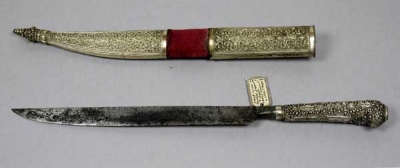Peasant knife (1941.10.83)
 GreecePeasant knife from Greece, Europe. Collected by Josephine Phelps. Given to the Museum in 1941.
GreecePeasant knife from Greece, Europe. Collected by Josephine Phelps. Given to the Museum in 1941.
This beautiful Greek dagger measures 30cm in length and probably dates to the 19th century. The wooden handle and sheath are covered with repoussé (beaten) silver. The central band is red velvet. It was used in dueling and formed part of the traditional costume of rural Greek men of the period.
Defining Gender
Knives like this were a widespread part of traditional male dress in early 19th century rural Greece, where knife-fighting accounted for 48% of all violent assaults recorded by the courts. Duelling emerged from a need for men to maintain their honour (timi) and reputation (fama) in a public culture where men indulged in boastful banter and back-biting gossip. Often, the cause of fights was one man insulting another by calling his wife a prostitute or suggesting that she was being unfaithful. The ability to control his wife's sexual activity was viewed as a reflection on a man's masculinity and, consequently, his status. The anxieties of men concerning their precarious honour and reputation motivated these violent incidents and created a culture of knife-carrying.
Honour duels usually took place in a local taverna and onlookers were forbidden to intervene until one combatant had drawn blood. The intention was to dishonour, slash the face, and wound, rather than kill. Once blood had been drawn, the victor spat on the victim, satisfaction was deemed to have been had, and the onlookers intervened to separate the men. A man who bore the facial scar of such a defeat was said to have undergone systolis ('diminishment'). The victor usually went gladly into police custody, in order to have a second opportunity to publicly assert his honour in the courtroom.
Greece was one of the last countries in Europe to outlaw the carrying of knives, only doing so in the 1830s when the Greek state and Orthodox Church combined forces to discourage men from bearing arms. The Church publicly excommunicated convicted violent criminals and the government ran a campaign promoting the idea that the carrying of knives was an 'un-European' practice. The carrying of knives in public was gradually abandoned and today they are worn only as part of traditional dance costumes.





